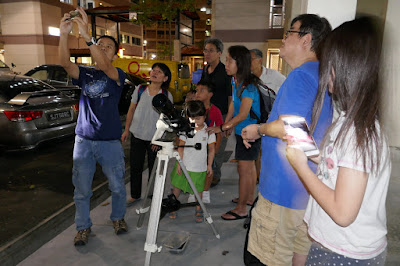*Heart rate increases*
Me: Ummm... yeah, we do. We have got wet weather programs lined up for the boys and girls. I will send an e-mail of the line up when we have finalized some stuff on our side.
It was all a bluff. I was putting on my best poker face. I had no Plan B ready in hand. I went back home and started thinking hard on what we could do if the weather really turned against us on the actual day of the event. Went online to do some research on astronomy activities but most of them are meant for small scale events of about 10-20 people, scaling it up would meant that it's going to be a logistical nightmare. So, I came up with a few astronomy-related games of my own.
Educators who are interested may take these ideas that I am sharing. No need to credit me. All I ask for is that you do not earn a monetary profit from these ideas.
It really depends on how many people are in your audience. Just play around with the numbers to form 2 teams. These games are generally inexpensive to organize. You may even set your own rules or alter the game play to suit your needs.
Premutation
of numbers of players: 60 pax = 2 teams of 30 players, 62 pax = 2
teams of 31 players, 64 pax = 2 teams of 32 players, 66 pax = 2 teams
of 33 players, 68 pax = 2 teams of 34 players, 70 pax = 2 teams of 35
players.
*In
the event that the total number of players is an odd number, get a
single organiser to participate in the games.
Form a constellation:
Items needed: 1000 glow
sticks, 75 sky maps.
*Important note:
Explain how to use the sky map and what are constellations before
starting the game. You can download the latest Sky Maps here: http://skymaps.com/downloads.html
- Form 2 teams of players. (let players decide which team to join)
- Choose a game captain from each team. (let players decide)
- Instruct all of them on how the game is being played using the sky map. (join 2 glow sticks for long constellation lines, use single glow sticks for short constellation lines, make the glow stick into a bracelet to make single stars forming the constellations, ignore other stars and planets in the sky map. Explain point system to them)
- Advise both game captains on their roles on assigning manpower to form certain constellations and their duty to present the constellations to the judges after they are done.
- Each team is given 500 glow sticks to recreate the constellations in the sky map.
- Each team is given 30 minutes to finish the game.
Total points for this
game is 20 points.
Leadership = 5 pts.
Teamwork = 5 pts.
Accuracy of sky map
recreation = 10 pts.
Planet Pong:
Items
needed: 8 small buckets, 1 soft ball, 1 whiteboard marker.
*Impotant
note: Explain the order of the planets to player before the game
starts
- Label each small bucket with a name of a planet in the Solar System using a whiteboard marker.
- Place buckets in order to the planets in the Solar System.
- Each player is handed a soft ball and has 3 throws.
- Players score points by successfully throwing ball into a bucket.
- Every bucket carries different points (Mercury = 1 point, Venus = 2 pts, Earth = 3 pts, Mars = 4 pts, Jupiter = 5 pts, Saturn = 6 pts, Uranus = 7 pts, Neptune = 8 pts)
- Encourage game captains to motivate the their teams to cheer for throwers.
Caught
by a flare:
Items needed: None
*Important
note: Explain to the players the dangers of solar flares and the
protective qualities of Earth's magnetic field from such solar
activities.
- Each team to select a catcher (solar flare) and a shield (magnetic field).
- The shield is responsible for shielding the rest of the players behind him/her and thus cannot be caught by the catcher.
- Starting from the second player behind the shield to the number 9th player can be caught and they are worth 2 points each. The 8 players represent the planets.
- Any players behind the number 9th player are considered astroids and are worth 1 point each when they are caught
- Any player caught by the catcher must be out of the game and report if he/she is a planet or an astroid to the judges.
- Total scores will be tabulated at the end of the game and the team that has the highest score wins the game. Prizes to be given out to the winning team.






















